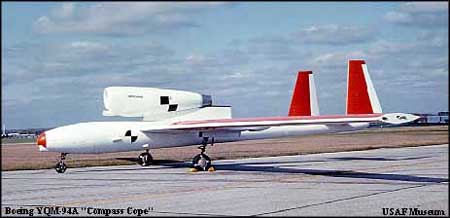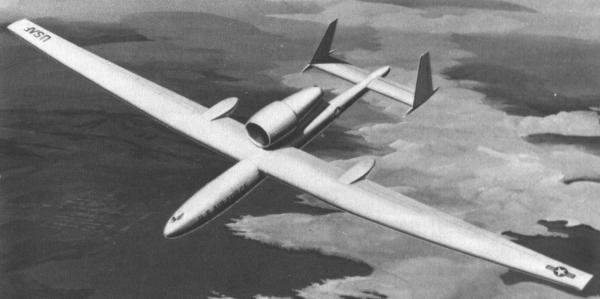Boeing GQM-94 B-Gull
In parallel to the ongoing test and development phase of the AQM-91 Firefly under the Compass Arrow program, the military and intelligence communities formulated a requirement for a high-altitude long-endurance RPV of still higher performance. The new vehicle, to be developed under the Compass Cope program, was to take off on its own from a conventional runway, and perform missions of up to 24 hours duration. The planned operational missions were to be flown day and night and in all weather, and included battlefield reconnaissance, SIGINT (Signal Intelligence), communications relay, photo reconnaissance, ocean surveillance and atmospheric sampling. In July 1971, Boeing received a contract to build two YQM-94A demonstrator vehicles for Compass Cope. In 1972, Teledyne Ryan was also awarded a contract for a second Compass Cope demonstrator, the YQM-98A. Boeing's aircraft was variously known as B-Gull, Compass Cope B or Cope-B.
 |
| Photo: U.S. Air Force Museum |
| YQM-94A |
The YQM-94A was of sailplane configuration with very high-aspect ratio wings, and was powered by a single General Electric J97 turbojet. It could reach altitudes of more than 16700 m (55000 ft). The aircraft did not have a capability for autonomous flight operations, and was flown manually throuout the mission. A pilot on the ground directed the RPV via a radio command control system, while watching the real-time image from a TV camera in the B-Gull's nose. The first flight of the YQM-94A occurred in July 1973, but the prototype crashed on its second flight a few days later. The second YQM-94A continued the flight test program more than a year later, in November 1974. The last flight with a duration of more than 17 hours verified the basic suitability of the B-Gull's design, and ended the test program. Late in the test program, or shortly after its termination, the designation of the vehicle was changed to YGQM-94A (after the "G-for-Runway" launch environment letter had been introduced into the missile designation system).
In August 1976, the USAF announced Boeing as the winner of the Compass Cope competition, and awarded a contract for YGQM-94B preproduction RPVs. This decision was not undisputed, because Teledyne Ryan's YGQM-98A had logged much more flight hours and demonstrated higher endurance. The YGQM-94B was to be a slightly longer and heavier vehicle, powered by a General Electric TF34 turbofan. Overall performance would have been somewhat higher than that of the YGQM-94A demonstrator. Unlike the latter, the YGQM-94B would have used a sophisticated flight control system to allow completely autonomous pre-planned missions from take-off to landing. However, in July 1977 the YGQM-94B was cancelled, officially because the planned payloads for the operational vehicle would not be available at the time needed. Some of the missions planned for the GQM-94 were eventually assigned to the manned U-2R aircraft.
 |
| Image: Boeing |
| YGQM-94B |
Specifications
Note: Data given by several sources show slight variations. Figures given below may therefore be inaccurate!
Data for YQM-94A, YGQM-94B:
| YQM-94A | YGQM-94B | |
|---|---|---|
| Length | 12.2 m (40 ft) | 15.2 m (50 ft) |
| Wingspan | 27.4 m (90 ft) | |
| Height | 3.86 m (12 ft 8 in) | ? |
| Weight | 6520 kg (14400 lb) | 7800 kg (17220 lb) |
| Speed | Mach 0.6 (?) | |
| Ceiling | > 16700 m (55000 ft) | > 18300 m (60000 ft) |
| Range | ? | 16000 km (8600 nm) |
| Endurance | > 17 hours | 27 hours |
| Propulsion | General Electric J97-GE-100 turbojet; 23.4 kN (5270 lb) | General Electric TF34-GE-100 turbofan; 26.7 kN (6000 lb) |
Main Sources
[1] Kenneth Munson: "World Unmanned Aircraft", Jane's, 1988
[2] William Wagner, William P. Sloan: "Fireflies and other UAVs", Midland Publishing, 1992
Back to Current Designations Of U.S. Unmanned Military Aerospace Vehicles
Back to
Directory of U.S. Military Rockets and Missiles
Last Updated: 14 October 2002